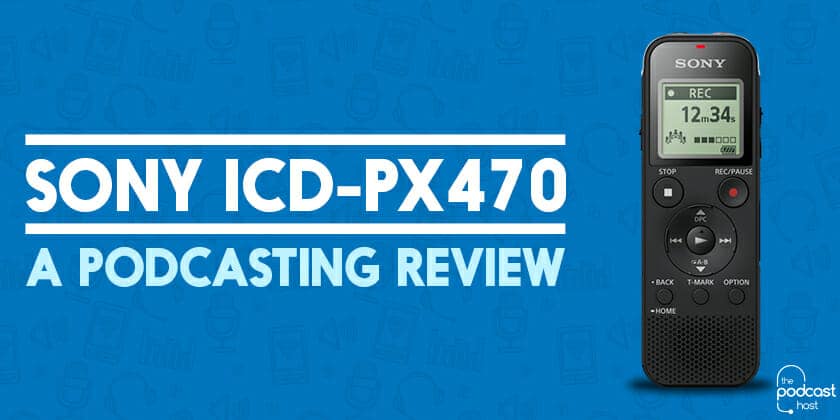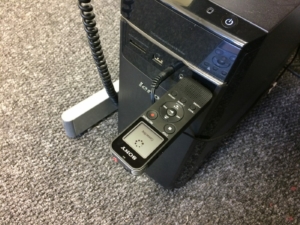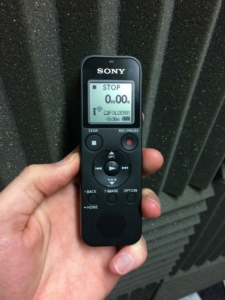The Sony ICD-PX470 Digital Recorder | A Podcasting Review

There’s a plethora of entry-level digital recorders on the market nowadays. And whilst I usually find myself recommending the Zoom H1 or the Tascam DR-05 to beginners, I’m always open to trying out new models.
Granted, the Sony ICD-PX470 probably isn’t designed to compete with the H1 or the DR-05, but it is made by Sony, who are certainly no amateurs in this game.
On top of that, it’s also around £30/$30 cheaper than the other two.
It would be more reasonable to compare the PX470 with the Olympus WS-853 – and it costs less than that model too.
The Sony ICD-PX470 is currently available on Amazon for $46 and Amazon UK for £44.
But, price isn’t everything of course. Is it any good for your podcasting needs? Read on and find out…
Look, Feel, & Design
One big positive that was immediately noticeable to me is that the recorder can be operated with one hand, using your thumb, in the same way you navigate your phone.
The built-in stereo mics are on the top of the recorder, along with the 3.5mm headphone and audio in external mic jacks. There’s a tactile dot beside the audio in jack, as well as on the play button, which is great from an accessibility point of view.
The display window on the front is always clear enough, and never too cluttered. It doesn’t have a backlight, however.
There’s a built-in speaker on the front too for listening back to your recordings.

Other Features
The recorder is powered by two AAA batteries. These are provided with the recorder, though they’re not rechargeable.
There’s a micro SD card slot on the side. An SD card isn’t included with the recorder, though it has 4GB of built-in storage.
The slider on the back pushes out a USB connection that lets you plug the recorder directly into your computer to access your files.
Buttons
There’s the standard record and stop buttons on the front. The record button doubles up as a pause button too, meaning you can pause then resume your recording.
On the front middle there’s the play button, surrounded by the four-way control button. Aside from toggling through the menus, you can also use this to access DPC (digital pitch control), repeat play, fast forward, and fast backwards.
There’s 3 smaller buttons on the front. A back/home button, a track-mark button for adding markers to audio inside the recorder, and an option button to access the settings.
On the sides there’s a playback volume button, and a power/hold button which switches the recorder on or off and can lock the device.
Recording
There’s a little indicator light above the display window which comes on when you’re recording. This flashes when you pause a recording.
Usually this type of light will flash when you peak/clip but this one doesn’t, though admittedly it’s hard to clip your recordings in any setting on the PX470.
You can apply a low-cut filter to reduce unwanted wind, handling, and popping noises in your recording.
There’s also an auto voice recording option which optimises audio settings for vocal frequencies, and helps further reduce unwanted background noise.
File Settings & Storage
You can record 4 different types of audio file.
WAV 44,100, 16 bit stereo – I’d recommend going with this unless you’re tight for storage space.
Two stereo MP3 settings are available, 192kbps and 128kbps. These are good enough quality as-is, but if you plan on editing your audio it’s always better to record in WAV format.
There’s a mono 48kbps option, but I’d try and avoid that, especially if you’ll be doing any editing later on.
I mentioned storage, and you can get nearly 60 hours of audio recording at 128kbps, whilst recording in WAV won’t get you much more than 5 total hours, so there might be certain situations where the former is the better option!
Levels
Setting your input volume levels is made pretty simple on the PX470.
You can select from 4 options, low, medium, high, or auto, in the mic sensitivity menu.
There’s a 6-bar input level meter on the display window during recording, and Sony advise that you look for that hitting around 3/6 or 4/6 for optimal results.
Scenes
The scene select menu is designed to let you pick a setting that fits your recording environment.
For podcasters, the two obvious ones here would be Interview or Voice Notes (solo) if you wanted to try something other than the auto voice setting.
There’s also Meeting which might suit a roundtable discussion, and Lecture which is designed to pick up (funnily enough) a lecture or front-room presentation.
Sound Quality
The PX470 is a low-cost device, but that’s arguably reflected in the audio quality, which is a little lower than I’d usually look for.
Here’s a sample on the ‘auto’ setting.
And here’s a sample on the ‘voice notes’ setting.
I haven’t applied any processing or cleaning to these samples, they’re exactly what was recorded.

Summary
The Sony ICD-PX470 is decent value for what it does.
It’s definitely an entry-level bit of kit with some limitations.
If I were a complete beginner in podcasting – and all my recordings were going to be done locally – and I was on a very tight budget, then I’d potentially see this as a worthy option.
But if you can afford the extra $30-odd and get a Zoom H1 or a Tascam DR-05 then that’s totally worth doing though.
The sound quality isn’t the greatest on the PX470, whilst the latter two are real studio quality recorders!
Need More Help Choosing Podcasting Equipment?
If you need some more tailored advice for your own setup, or want help with any other aspect of podcasting, then we’d love to work with you.
Inside Podcraft Academy we run regular live Q&A sessions, a community forum, and provide access to all of our video courses, tutorials, ebooks, and downloadable resources!
